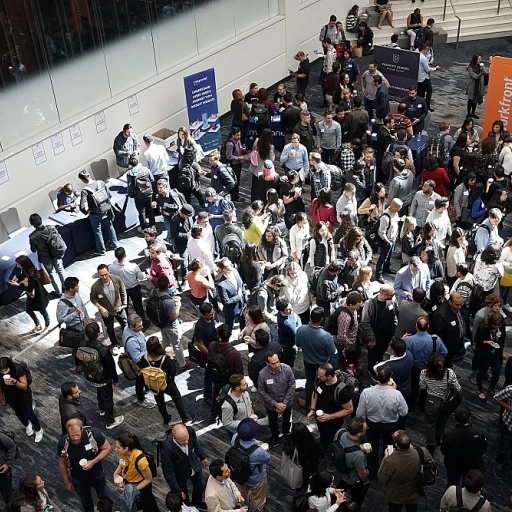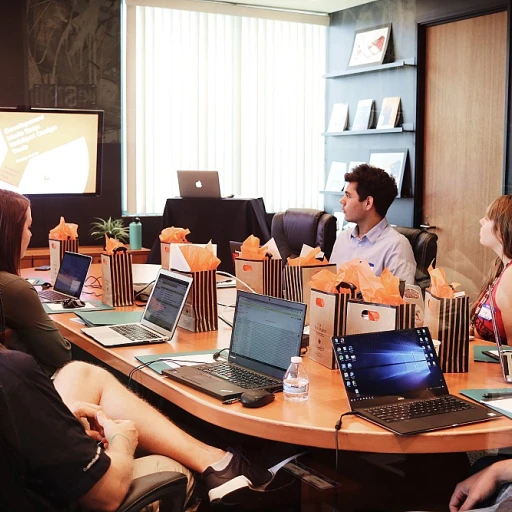Understanding the Role of a CHRO
The Evolution of the CHRO Role
The role of the Chief Human Resources Officer (CHRO) has significantly evolved over the years, transforming from a traditional HR manager into a strategic partner crucial to a company’s success. As businesses navigate complex global challenges, the CHRO has taken the helm in fostering a workforce that's engaged, productive, and aligned with organizational goals. In this era of rapid change, understanding the multifaceted responsibilities of a CHRO becomes essential.
The modern CHRO goes beyond managing benefits and payroll; they are pivotal in shaping company culture and driving forward initiatives that are aligned with the company’s mission and vision. By implementing workforce strategies, they ensure that talent management aligns with the broader business objectives. This strategic role allows CHROs to make impactful decisions that resonate throughout the organization, influencing everything from employee engagement to cultural transformations.
But what exactly defines a CHRO, and how does this role differ from the HR executives of the past? The CHRO is tasked with navigating digital transformations, upholding diversity, equity, and inclusion principles, and shaping the future of work. Each of these aspects reflects the comprehensive nature of their role, proving their indispensability within the corporate structure. By
understanding the full scope, one can appreciate how critical the CHRO is in the ever-evolving business landscape.
Employee Engagement: A CHRO's Perspective
A CHRO's Perspective on Fostering Employee Engagement
Employee engagement is a critical element that can significantly influence an organization's success. As the Chief Human Resources Officer (CHRO), understanding and enhancing employee engagement is not just about creating satisfaction; it’s about cultivating a committed and motivated workforce.
CHROs are uniquely positioned to interpret and influence the many factors that drive employee engagement. These factors often include ensuring that employees feel their work is meaningful, they have opportunities for career development, and there is a clear communication of the organization's vision and goals. By honing in on these areas, CHROs can foster an environment where employees are not just workers, but active contributors to their company's growth.
A strategic approach is needed to truly elevate engagement levels. This involves regularly measuring engagement through surveys and feedback channels, keeping a finger on the pulse of employee sentiment. Once this information is obtained, it's crucial to act on it. The CHRO should champion initiatives that build a positive culture, recognizing and rewarding employee contributions, and supporting career development opportunities.
Moreover, CHROs can drive change by aligning engagement efforts with the organization’s overall strategy and goals. By doing so, they ensure that employees see a direct correlation between their efforts and the company’s success. This holistic approach to engagement is vital, as it intertwines employee satisfaction with organizational growth. For more insights on this intersection, explore the
role of the CHRO in driving organizational growth.
In the next phases, leveraging technology will be another crucial aspect to enhance the digital employee experience, creating a seamless and more connected workplace.
Leveraging Technology for a Digital Employee Experience
Embracing Technology in a Digital Landscape
In the contemporary corporate environment, the Chief Human Resources Officer (CHRO) is tasked with navigating the complexities of the digital world to enhance workforce engagement and productivity. As we discussed earlier in our exploration of the role, a CHRO's influence extends beyond traditional HR functions, playing a strategic part in fostering a cohesive and thriving workplace.
One of the pivotal ways a CHRO can elevate employee experience is by leveraging technology to create a seamless and efficient digital ecosystem. This technological transition is not solely about automating processes but also ensuring that the workforce is equipped with tools that foster collaboration, communication, and continuous development.
With the rise of digital platforms, CHROs are increasingly focusing on integrating solutions that cater to diverse employee needs. Whether it's through implementing user-friendly HR systems, promoting flexible work arrangements, or facilitating virtual learning and development programs, technology plays a crucial role in supporting a robust employee engagement strategy. For organizational leaders interested in crafting a winning workforce strategy, considering how digital solutions intertwine with employee experience is paramount.
As organizations continue to adapt to rapidly changing environments, the digital employee experience remains a key aspect of the CHRO's vision for the future of work. The ability to anticipate and embrace technological advancements will not only enhance the well-being of employees but also drive competitive advantage, making it a worthy focal point for any forward-thinking CHRO. For more insights on the pivotal role of technology in workforce strategy, exploring further resources can be invaluable.
Crafting a winning workforce strategy offers additional guidance for CHROs looking to harness the power of technology in their efforts.
Balancing Work and Life: The CHRO's Approach
Designing Work-Life Integration Policies
For a Chief Human Resources Officer, the challenge of balancing work and life for employees is not just about crafting policies but about designing a holistic environment where employees feel that their personal time is respected. The notion of work-life balance has evolved, particularly in the wake of increased remote work, to something more integrated. In this context, CHROs play a pivotal role in ensuring that employees are not only engaged but also that they have the flexibility to integrate their personal and professional lives seamlessly.
Flexible Work Arrangements
A key strategy in achieving this balance is offering flexible work arrangements. This includes flexible hours, remote work options, and even compressed workweeks where feasible. By providing these options, CHROs help reduce stress and burnout, leading to higher productivity and overall job satisfaction among employees. However, it’s crucial that these arrangements are accompanied by clear policies and guidelines to ensure fairness and consistency across the organization.
Encouraging a Culture of Wellness
CHROs understand that promoting employee wellness extends beyond physical health—it encompasses mental and emotional well-being too. Initiatives such as mental health support programs, wellness days, and promoting work-life balance through example and leadership buy-in are essential. By fostering a culture that prioritizes wellness, CHROs can positively impact employee morale and retention.
Training Managers and Leaders
To successfully implement work-life integration strategies, CHROs must also focus on equipping managers and leaders with the skills to support their teams. This includes training them to recognize signs of stress and burnout and encouraging open communication lines. Managers should be empowered to adapt work plans that allow employees to manage personal obligations alongside their professional responsibilities effectively.
Diversity, Equity, and Inclusion: A Priority for CHROs
CHROs Championing Diversity, Equity, and Inclusion
The role of the Chief Human Resources Officer is integral to fostering a workplace where diversity, equity, and inclusion (DEI) are not just buzzwords but core values embedded in the organizational fabric. In understanding the broader responsibilities of a CHRO, DEI initiatives stand out as pivotal in shaping an enriching employee experience.
A CHRO today is tasked with creating and sustaining a diverse workforce that mirrors the rich variety of perspectives found across society. This involves implementing policies that support hiring from various backgrounds, ensuring pay equity, and nurturing an inclusive culture where every employee feels valued and empowered. It's not merely about numbers; it's about creating an environment where diversity thrives.
Equally important is equity, which requires a CHRO to rigorously examine existing practices to uncover and address disparities. This involves transparent communication and a commitment to fair treatment for all employees. By challenging traditional biases and fostering open dialogues, CHROs can spearhead initiatives that promote a level playing field.
Inclusion, the third pillar, emphasizes the importance of belongingness within the workplace. A CHRO is pivotal in implementing strategies that encourage collaboration and respect across all levels of the organization. This might include mentorship programs, employee resource groups, or training sessions designed to foster a culture of inclusivity.
The emphasis on DEI is not an isolated initiative but rather a complement to the CHRO's overarching goal of promoting employee engagement, as discussed previously. By acknowledging the unique strengths each individual brings, CHROs not only facilitate a positive workplace culture but also drive greater organizational success.
In the landscape of rapidly evolving work environments, a CHRO's commitment to diversity, equity, and inclusion becomes a source of innovative strength, empowering employees and ensuring that organizations are well-prepared for the future.
Future of Work: The CHRO's Vision
The Evolution of Remote and Hybrid Work
As organizations continue to grapple with the dynamics of a rapidly changing world, the future of work stands at a fascinating crossroads. Chief Human Resources Officers (CHROs) are at the forefront, crafting strategies to ensure their organizations remain competitive, adaptable, and inclusive.
The shift towards remote and hybrid work models has been one of the most significant transformations in recent times. CHROs are tasked with designing policies that accommodate this new norm, balancing the flexibility employees have come to value with the need for collaboration and maintaining company culture.
Embracing Technological Advancements
Technology plays a pivotal role in shaping the employee experience in this new era. Digital tools not only facilitate seamless remote work but also drive employee engagement and productivity. As discussed earlier, CHROs must bridge the gap between technology and human interaction, creating platforms that not only support work processes but also foster an engaging digital environment.
Preparing for Workforce Diversity and Inclusivity
With the changing face of the workforce, CHROs are also focusing on diversity, equity, and inclusion as paramount elements of their strategy. The ability to harness diverse perspectives and create an inclusive workplace will set apart future-ready organizations. It’s not merely a social mandate, but a business imperative that enhances innovation and resilience.
Building Resilience and Adaptability
The ability to adapt is now a crucial trait for any organization. CHROs must instill a culture of resilience and lifelong learning among employees. This involves not just offering training and development opportunities but also ensuring that employees feel empowered and supported in a rapidly changing landscape.
The future of work is indeed exciting and promising, with CHROs playing a pivotal role in navigating these transformations. With strategic vision and innovative frameworks, CHROs are indeed driving the evolution of the workplace, making it more dynamic and human-centric than ever before.








